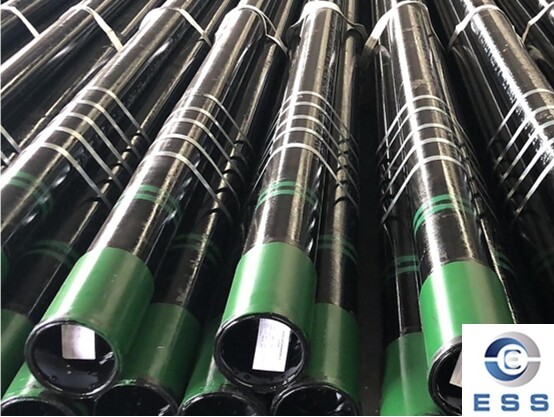
Ordinary connection type casing pup joints
1. Structural features:
Both ends have standard casing pipe connection threads, which usually match the casing pipe threads of the same
specification, and the thread precision requirements are high to ensure the
tightness and sealing of the connection. For example, the API standard casing
pup joint thread meets the API specification, and the parameters such as tooth
type and pitch are precisely controlled, so that the pup joint can be smoothly
connected with other casing pipes to form a complete casing string.
The shape of the pipe body is a simple
cylinder, and its outer diameter and wall thickness are the same as the
connected casing pipe, which ensures the structural consistency of the entire
casing string and the smoothness of fluid passage.
2. Application scenarios:
It is mainly used to connect casing pipes
of the same specification when the length of the casing string is adjusted. For
example, in conventional oil drilling, when the total length of the casing
string deviates slightly from the designed well depth, the length can be
accurately adjusted by inserting the ordinary connection type casing pup joint,
so that the casing pipe can be accurately lowered to the predetermined depth.
Variable diameter casing pup joint
1. Structural features:
The outer diameters of the two ends are
different, showing a gradient shape. This pup joint is designed to connect
casing pipes of different outer diameters. In the transition section, the outer
diameter of the pup joint gradually changes from one specification to another
to ensure that the fluid can smoothly transition between different pipe
diameters and reduce pressure loss and turbulence.
Its internal structure will also be
optimized according to the difference in the inner diameters of the connecting
casing pipes at both ends. For example, there may be a certain taper design
inside so that the fluid will not generate greater resistance when flowing
through the pup joint due to the sudden change in pipe diameter.
2. Application scenarios:
Used to integrate casing strings with
different outer diameters. In complex oil well structures, due to changes in
formation conditions or drilling design, casing pipes of different outer
diameters may need to be used to adapt to the pressure and stability
requirements of different formations. The variable diameter casing pup joint
can effectively connect these casing pipes of different outer diameters to
build a complete casing pipe system. For example, when drilling in soft and
hard alternating formations, the upper softer formation may use a larger outer
diameter casing pipe to provide better support, and the lower harder formation
may use a smaller outer diameter casing pipe to reduce costs. The variable
diameter casing pup joint is used to connect these two different outer diameter
casing pipes.
Special function casing pup joints
1. Structural features:
With special auxiliary structures or
functional components. For example, the position, size and number of the side
holes of the casing pup joints with side holes are designed according to
specific functional requirements. These side holes can be used for diversion,
injection or installation of special downhole monitoring equipment for downhole
fluids.
Some special function casing pup joints may
have special coatings or linings inside. If it is used for corrosion
prevention, there may be corrosion-resistant coatings, such as epoxy coatings,
whose thickness and uniformity will be strictly controlled to ensure effective
anti-corrosion performance; if it is used for heat insulation, there may be
insulation material linings, whose materials and structures can effectively
isolate heat transfer.
2. Application scenarios:
Used to achieve specific downhole operation
functions. When performing oil well stimulation measures such as acidizing and
fracturing, the casing pup joints with side holes can accurately inject acid or
fracturing fluid into specific formation positions. In terms of downhole
monitoring, special function casing pup joints equipped with sensor interfaces
can monitor downhole pressure, temperature, flow and other parameters in real
time, providing important data support for oil well production management. For example,
in some high-temperature and high-pressure oil wells, special-function casing
pup joints equipped with temperature sensors can timely feedback the
temperature changes downhole, helping operators to determine whether the
production status of the oil well is normal.
Summary
The above is a detailed introduction to the
structural characteristics and application scenarios of different casing pup
joints. When purchasing or using casing pup joints, it is necessary to select
appropriate casing pup joints according to the operating environment and
functional requirements to play their correct role and improve work efficiency.













 Eastern Steel Manufacturing Co.,Ltd not only improve product production and sales services, but also provide additional value-added services. As long as you need, we can complete your specific needs together.
Eastern Steel Manufacturing Co.,Ltd not only improve product production and sales services, but also provide additional value-added services. As long as you need, we can complete your specific needs together.










